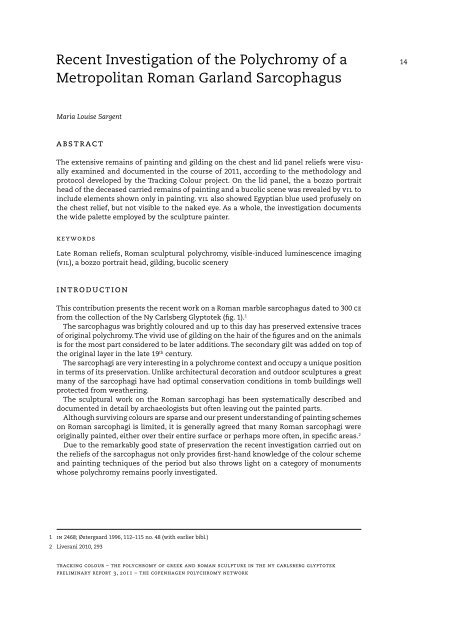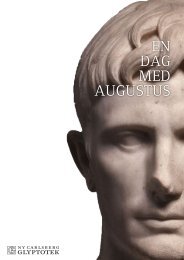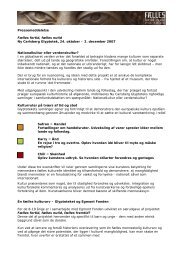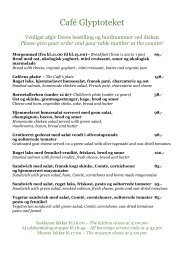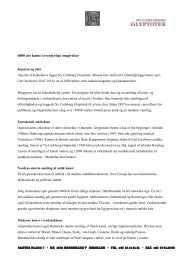Preliminary Report 3, 2011 - Ny Carlsberg Glyptotek
Preliminary Report 3, 2011 - Ny Carlsberg Glyptotek
Preliminary Report 3, 2011 - Ny Carlsberg Glyptotek
You also want an ePaper? Increase the reach of your titles
YUMPU automatically turns print PDFs into web optimized ePapers that Google loves.
Recent Investigation of the Polychromy of a<br />
Metropolitan Roman Garland Sarcophagus<br />
14<br />
Maria Louise Sargent<br />
Abstract<br />
The extensive remains of painting and gilding on the chest and lid panel reliefs were visually<br />
examined and documented in the course of <strong>2011</strong>, according to the methodology and<br />
protocol developed by the Tracking Colour project. On the lid panel, the a bozzo portrait<br />
head of the deceased carried remains of painting and a bucolic scene was revealed by VIL to<br />
include elements shown only in painting. VIL also showed Egyptian blue used profusely on<br />
the chest relief, but not visible to the naked eye. As a whole, the investigation documents<br />
the wide palette employed by the sculpture painter.<br />
Keywords<br />
Late Roman reliefs, Roman sculptural polychromy, visible-induced luminescence imaging<br />
(VIL), a bozzo portrait head, gilding, bucolic scenery<br />
Introduction<br />
This contribution presents the recent work on a Roman marble sarcophagus dated to 300 CE<br />
from the collection of the <strong>Ny</strong> <strong>Carlsberg</strong> <strong>Glyptotek</strong> (fig. 1). 1<br />
The sarcophagus was brightly coloured and up to this day has preserved extensive traces<br />
of original polychromy. The vivid use of gilding on the hair of the figures and on the animals<br />
is for the most part considered to be later additions. The secondary gilt was added on top of<br />
the original layer in the late 19 th century.<br />
The sarcophagi are very interesting in a polychrome context and occupy a unique position<br />
in terms of its preservation. Unlike architectural decoration and outdoor sculptures a great<br />
many of the sarcophagi have had optimal conservation conditions in tomb buildings well<br />
protected from weathering.<br />
The sculptural work on the Roman sarcophagi has been systematically described and<br />
documented in detail by archaeologists but often leaving out the painted parts.<br />
Although surviving colours are sparse and our present understanding of painting schemes<br />
on Roman sarcophagi is limited, it is generally agreed that many Roman sarcophagi were<br />
originally painted, either over their entire surface or perhaps more often, in specific areas. 2<br />
Due to the remarkably good state of preservation the recent investigation carried out on<br />
the reliefs of the sarcophagus not only provides first-hand knowledge of the colour scheme<br />
and painting techniques of the period but also throws light on a category of monuments<br />
whose polychromy remains poorly investigated.<br />
1 IN 2468; Østergaard 1996, 112–115 no. 48 (with earlier bibl.)<br />
2 Liverani 2010, 293<br />
tracking colour – The polychromy of Greek and Roman sculpture in the <strong>Ny</strong> <strong>Carlsberg</strong> <strong>Glyptotek</strong><br />
<strong>Preliminary</strong> <strong>Report</strong> 3, <strong>2011</strong> – the copenhagen polychromy network


